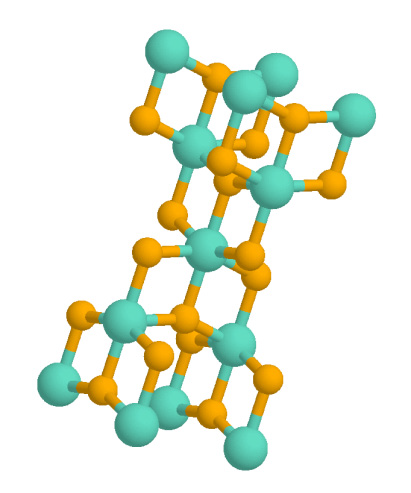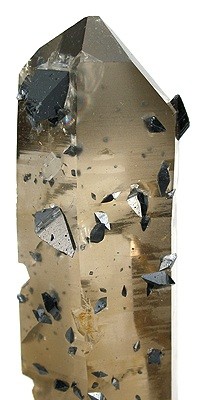|
Brookite
Brookite is the orthorhombic variant of titanium dioxide (TiO2), which occurs in four known natural polymorphic forms (minerals with the same composition but different structure). The other three of these forms are akaogiite (monoclinic), anatase (tetragonal) and rutile (tetragonal). Brookite is rare compared to anatase and rutile and, like these forms, it exhibits photocatalytic activity. Brookite also has a larger cell volume than either anatase or rutile, with 8 TiO2 groups per unit cell, compared with 4 for anatase and 2 for rutile.Anatase and Brookite . Wikis.lib.ncsu.edu (2007-05-08). Retrieved on 2011-10-14. (Fe), |
Armand Lévy (mineralogist)
Serve-Dieu Abailard "Armand" Lévy (14 November 1795 – 29 July 1841) was a French mathematician and mineralogist. He is remembered in the Haüy-Lévy notation for describing mineral crystal structures. Life Lévy was born in Paris where his Jewish businessman father had married Céline Mailfert, a Catholic. Although his birth and death records have his given names as Serve-Dieu Abailard, he registered with the Geological Society of London under the name Armand. Armand Lévy studied mathematics, passing his agrégation in 1816 from the École Normale Supérieure. His Jewish origin prevented him from obtaining jobs in France and took up an offer Collège Royal on Reunion Island. While sailing to the Indian Ocean, his ship was wrecked off Plymouth. He then settled in London where he made a living by giving mathematics tuitions and in 1820 he met a mineral dealer, Henry Heuland, who asked him to categorise his collection as part of its sale to Charles Hampden Turner. In London ... [...More Info...] [...Related Items...] OR: [Wikipedia] [Google] [Baidu] |
Titanium Dioxide
Titanium dioxide, also known as titanium(IV) oxide or titania , is the inorganic compound with the chemical formula . When used as a pigment, it is called titanium white, Pigment White 6 (PW6), or CI 77891. It is a white solid that is insoluble to water, although mineral forms can appear black. As a pigment, it has a wide range of applications, including paint, sunscreen, and food coloring. When used as a food coloring, it has E number E171. World production in 2014 exceeded 9 million tonnes. It has been estimated that titanium dioxide is used in two-thirds of all pigments, and pigments based on the oxide have been valued at a price of $13.2 billion. Structure In all three of its main dioxides, titanium exhibits octahedral geometry, being bonded to six oxide anions. The oxides in turn are bonded to three Ti centers. The overall crystal structure of rutile is tetragonal in symmetry whereas anatase and brookite are orthorhombic. The oxygen substructures are all slight dist ... [...More Info...] [...Related Items...] OR: [Wikipedia] [Google] [Baidu] |
Oxide Minerals
The oxide mineral class includes those minerals in which the oxide anion (O2−) is bonded to one or more metal alloys. The hydroxide-bearing minerals are typically included in the oxide class. The minerals with complex anion groups such as the silicates, sulfates, carbonates and phosphates are classed separately. Simple oxides: *XO **Periclase group *** Periclase *** Manganosite **Zincite group *** Zincite *** Bromellite *** Tenorite *** Litharge * ** Cuprite ** Ice * **Hematite group ***Corundum ***Hematite *** Ilmenite * **Rutile group *** Rutile *** Pyrolusite *** Cassiterite ** Baddeleyite ** Uraninite ** Thorianite * **Spinel group *** Spinel *** Gahnite ***Magnetite ***Franklinite *** Chromite ** Chrysoberyl ** Columbite *Hydroxide subgroup: ** Brucite ** Manganite **Romanèchite **Goethite group: *** Diaspore *** Goethite Nickel–Strunz Classification -04- Oxides IMA-CNMNC proposes a new hierarchical scheme (Mills et al., 2009). ... [...More Info...] [...Related Items...] OR: [Wikipedia] [Google] [Baidu] |
Murun Massif
Murun (russian: Мурун) is a mountain in the Olyokma-Chara Plateau, at the border of Irkutsk Oblast and Yakutia, Russian Federation. Geography A high summit is the highest point of the Murun Massif in the Olyokma-Chara Plateau, part of the South Siberian mountain system. The massif is about across and rises in the central/southern part of the plateau, above the right bank of the Chara, west of the valley of the Tokko, at the southwestern end of the Sakha Republic, bordering with Irkutsk Oblast, near the tripoint with Zabaykalsky Krai. The mountain is near Torgo, an abandoned settlement in Olyokminsky District. Google Earth The Murun peak is marked as a summit in the O-50 sheet of the Soviet Topographic Map. This same mountain, however, is a peak in the D-7 sheet of the Defense Mapping Agency Navigation charts. The Irkutsk Oblast-Yakutia border runs across the middle of the Murun Massif and the peak rises on the western, or Irkutsk Oblast side. Geology The massif ... [...More Info...] [...Related Items...] OR: [Wikipedia] [Google] [Baidu] |
Henry James Brooke
Henry James Brooke (1771–1857) was an English crystallographer. Life Brooke was the son of a broadcloth manufacturer, born in Exeter on 25 May 1771. He studied for the bar, but went into business in the Spanish wool trade, South American mining companies, and the London Life Assurance Association successively. Brooke's hobbies were mineralogy, geology, and botany. His large collections of shells and of minerals were presented to the University of Cambridge, while a portion of his collection of engravings was given by him to the British Museum. He was elected a Fellow of the Geological Society in 1815, Fellow of the Linnean Society in 1818, Fellow of the Royal Society in 1819, and a Foreign Honorary Member of the American Academy of Arts and Sciences in 1825. . He discovered thirteen new mineral species. Brooke died at Clapham Rise on 26 June 1857 and was buried at West Norwood Cemetery. The surgeon Charles Brooke was his son. Works Brooke published a ''Familiar Introduction ... [...More Info...] [...Related Items...] OR: [Wikipedia] [Google] [Baidu] |
Anatase
Anatase is a metastable mineral form of titanium dioxide (TiO2) with a tetragonal crystal structure. Although colorless or white when pure, anatase in nature is usually a black solid due to impurities. Three other polymorphs (or mineral forms) of titanium dioxide are known to occur naturally: brookite, akaogiite, and rutile, with rutile being the most common and most stable of the bunch. Anatase is formed at relatively low temperatures and found in minor concentrations in igneous and metamorphic rocks. Thin films of TiO2-coated glass show antifogging and self-cleaning properties under ultraviolet radiation. Anatase is always found as small, isolated, and sharply developed crystals, and like rutile, it crystallizes in a tetragonal system. Anatase is metastable at all temperatures and pressures, with rutile being the equilibrium polymorph. Nevertheless, anatase is often the first titanium dioxide phase to form in many processes due to its lower surface energy, with a trans ... [...More Info...] [...Related Items...] OR: [Wikipedia] [Google] [Baidu] |
Polymorphism (materials Science)
In materials science, polymorphism describes the existence of a solid material in more than one form or crystal structure. Polymorphism is a form of isomerism. Any crystalline material can exhibit the phenomenon. Allotropy refers to polymorphism for chemical elements. Polymorphism is of practical relevance to pharmaceuticals, agrochemicals, pigments, dyestuffs, foods, and explosives. According to IUPAC, a polymorphic transition is "A reversible transition of a solid crystalline phase at a certain temperature and pressure (the inversion point) to another phase of the same chemical composition with a different crystal structure." According to McCrone, polymorphs are "different in crystal structure but identical in the liquid or vapor states." Materials with two polymorphs are called dimorphic, with three polymorphs, trimorphic, etc. Examples Many compounds exhibit polymorphism. It has been claimed that "every compound has different polymorphic forms, and that, in general, the nu ... [...More Info...] [...Related Items...] OR: [Wikipedia] [Google] [Baidu] |
Chemical Formula
In chemistry, a chemical formula is a way of presenting information about the chemical proportions of atoms that constitute a particular chemical compound or molecule, using chemical element symbols, numbers, and sometimes also other symbols, such as parentheses, dashes, brackets, commas and ''plus'' (+) and ''minus'' (−) signs. These are limited to a single typographic line of symbols, which may include subscripts and superscripts. A chemical formula is not a chemical name, and it contains no words. Although a chemical formula may imply certain simple chemical structures, it is not the same as a full chemical structural formula. Chemical formulae can fully specify the structure of only the simplest of molecules and chemical substances, and are generally more limited in power than chemical names and structural formulae. The simplest types of chemical formulae are called '' empirical formulae'', which use letters and numbers indicating the numerical ''proportions'' of ato ... [...More Info...] [...Related Items...] OR: [Wikipedia] [Google] [Baidu] |
Octahedron
In geometry, an octahedron (plural: octahedra, octahedrons) is a polyhedron with eight faces. The term is most commonly used to refer to the regular octahedron, a Platonic solid composed of eight equilateral triangles, four of which meet at each vertex. A regular octahedron is the dual polyhedron of a cube. It is a rectified tetrahedron. It is a square bipyramid in any of three orthogonal orientations. It is also a triangular antiprism in any of four orientations. An octahedron is the three-dimensional case of the more general concept of a cross polytope. A regular octahedron is a 3-ball in the Manhattan () metric. Regular octahedron Dimensions If the edge length of a regular octahedron is ''a'', the radius of a circumscribed sphere (one that touches the octahedron at all vertices) is :r_u = \frac a \approx 0.707 \cdot a and the radius of an inscribed sphere (tangent to each of the octahedron's faces) is :r_i = \frac a \approx 0.408\cdot a while the midradius, whic ... [...More Info...] [...Related Items...] OR: [Wikipedia] [Google] [Baidu] |
Space Group
In mathematics, physics and chemistry, a space group is the symmetry group of an object in space, usually in three dimensions. The elements of a space group (its symmetry operations) are the rigid transformations of an object that leave it unchanged. In three dimensions, space groups are classified into 219 distinct types, or 230 types if chiral copies are considered distinct. Space groups are discrete cocompact groups of isometries of an oriented Euclidean space in any number of dimensions. In dimensions other than 3, they are sometimes called Bieberbach groups. In crystallography, space groups are also called the crystallographic or Fedorov groups, and represent a description of the symmetry of the crystal. A definitive source regarding 3-dimensional space groups is the ''International Tables for Crystallography'' . History Space groups in 2 dimensions are the 17 wallpaper groups which have been known for several centuries, though the proof that the list was compl ... [...More Info...] [...Related Items...] OR: [Wikipedia] [Google] [Baidu] |
Crystallographic Point Group
In crystallography, a crystallographic point group is a set of symmetry operations, corresponding to one of the point groups in three dimensions, such that each operation (perhaps followed by a translation) would leave the structure of a crystal unchanged i.e. the same kinds of atoms would be placed in similar positions as before the transformation. For example, in many crystals in the cubic crystal system, a rotation of the unit cell by 90 degrees around an axis that is perpendicular to one of the faces of the cube is a symmetry operation that moves each atom to the location of another atom of the same kind, leaving the overall structure of the crystal unaffected. In the classification of crystals, each point group defines a so-called (geometric) crystal class. There are infinitely many three-dimensional point groups. However, the crystallographic restriction on the general point groups results in there being only 32 crystallographic point groups. These 32 point groups are one-an ... [...More Info...] [...Related Items...] OR: [Wikipedia] [Google] [Baidu] |




.png)